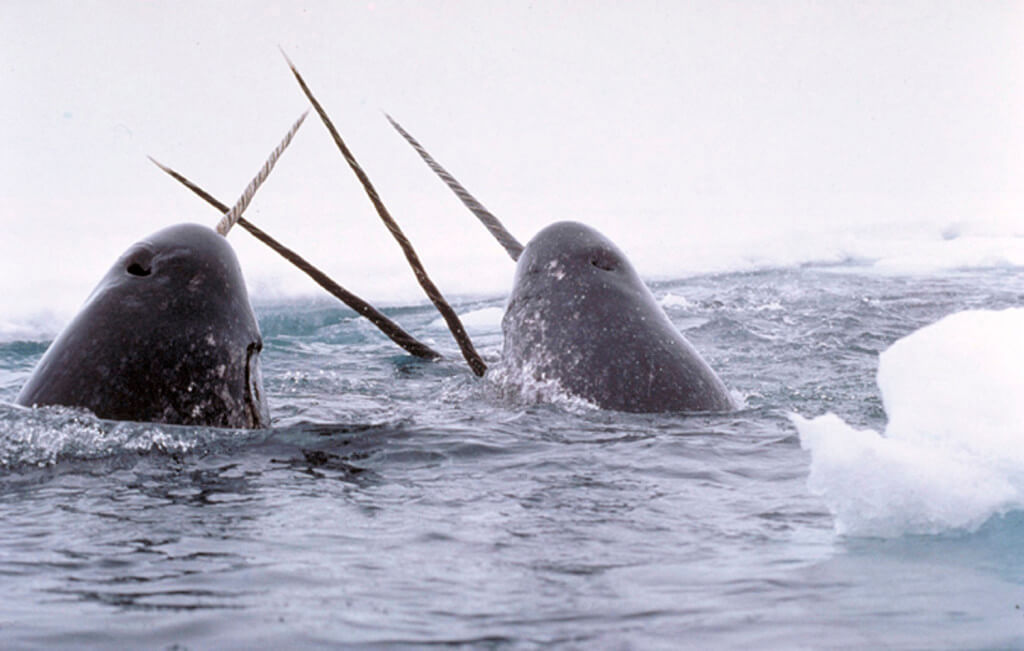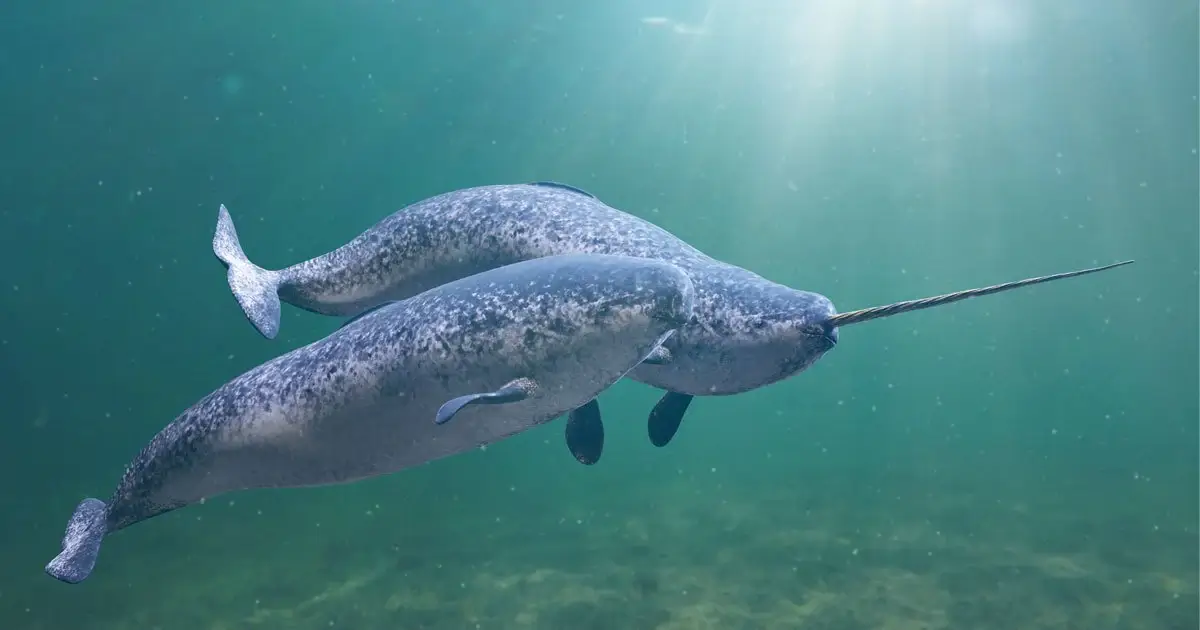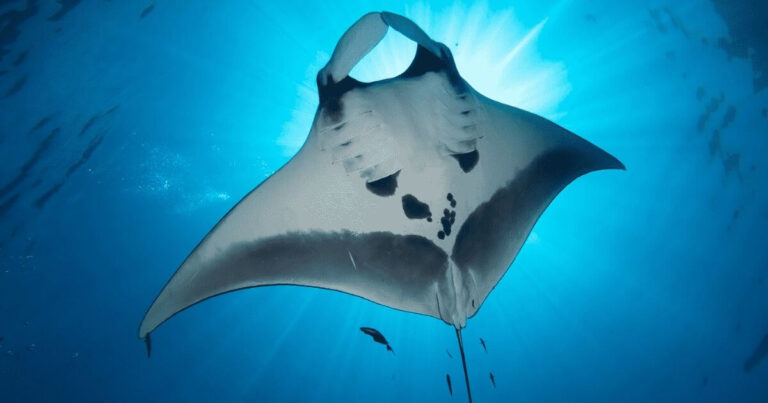Narwhal: Discover the Arctic’s Unicorn of the Sea
The narwhal (Monodon monoceros) is a fascinating marine mammal known for its spiral tusk, often called the “unicorn of the sea.” This unique species captivates scientists and enthusiasts with its mysterious nature and remote Arctic habitat. Below is a comprehensive look into the narwhal’s world, covering its classification, characteristics, and more.
Contents
Scientific Classification
- Kingdom: Animalia
- Phylum: Chordata
- Class: Mammalia
- Order: Cetacea
- Family: Monodontidae
- Genus: Monodon
- Species: M. monoceros
The narwhal shares its family, Monodontidae, with another Arctic cetacean, the beluga whale. Despite their close relationship, narwhals are easily distinguished by their characteristic tusk.
Physical Characteristics

- Size: Males typically reach lengths of 4-5 meters (13-16 feet), while females are slightly smaller, averaging 3.5-4 meters (11.5-13 feet).
- Weight: Adult narwhals weigh between 800 to 1,600 kg (1,800-3,500 pounds).
- Coloration: Narwhals are born bluish-grey and gradually develop mottled, speckled skin as they age. Older narwhals are paler, with more pronounced speckles.
- Tusk: The narwhal’s most distinctive feature is its long tusk, an elongated tooth that can grow up to 3 meters (10 feet). The tusk, usually found in males, spirals counterclockwise and is used for various purposes, including mating displays and possibly even hunting.
Habitat and Distribution
Narwhals inhabit the icy waters of the Arctic, particularly around Greenland, Canada, and Russia. They are highly adapted to cold environments and are often found in regions with dense sea ice, where they navigate using cracks and leads in the ice.
Common Locations:
- Baffin Bay
- Hudson Bay
- Canadian Arctic Archipelago
- Northern Russia (Franz Josef Land)
Behavior and Social Structure

Narwhals are social animals, typically found in groups, or “pods,” of 10-20 individuals, though larger groups can form in the summer months. Their behavior includes deep diving, often reaching depths of up to 1,500 meters (4,920 feet) in search of prey.
- Communication: Narwhals use echolocation to navigate and hunt in dark or murky waters. They emit a range of clicks, whistles, and pulsed sounds.
- Migration: Narwhals undertake seasonal migrations, moving to offshore, ice-free waters in the winter and returning to coastal regions in the summer.
Diet
Narwhals primarily feed on fish, squid, and shrimp. Their diet varies by season, with Arctic cod and Greenland halibut staples during winter. Interestingly, despite their reliance on deep-sea hunting, narwhals have a relatively small number of prey species compared to other cetaceans.
Reproduction and Life Cycle
Narwhals have a slow reproductive cycle, with females typically giving birth to a single calf every three years.
- Gestation Period: 14-15 months
- Calving Season: Most calves are born between June and August.
- Lifespan: Narwhals can live up to 50 years in the wild.
- Maturity: Females reach sexual maturity at 4-7 years, while males mature slightly later, around 7-9 years.
Predators and Threats
The main predators of narwhals are orcas (killer whales) and polar bears. Orcas hunt narwhals by trapping them against sea ice, while polar bears may attack narwhals that become stranded in shallow waters or ice. Humans also pose a threat to narwhals through hunting, primarily by Indigenous Arctic communities, though this is regulated.
Conservation Status
According to the International Union for Conservation of Nature (IUCN), narwhals are classified as “Near Threatened.”
Conservation Concerns:
- Climate Change: The melting of Arctic ice is one of the most significant threats to narwhal populations, affecting their habitat and prey availability.
- Human Activities: Increasing industrial activity in the Arctic, including shipping and oil exploration, poses risks due to habitat disruption and pollution.
- Hunting: While traditional Inuit hunting of narwhals is regulated and plays a cultural role, overharvesting in some areas remains a concern.
Interesting Facts
- The Tusk: Recent research suggests that the narwhal’s tusk may function as a sensory organ, detecting changes in water temperature, salinity, and pressure.
- Deep Divers: Narwhals are among the deepest-diving marine mammals, capable of descending over 1.5 kilometres (5,000 feet) in search of food.
- Lack of Dorsal Fin: Unlike many other whale species, narwhals lack a dorsal fin, which allows them to swim more easily beneath the ice.
Evolutionary History
The narwhal’s tusk is an evolutionary mystery. Some theories suggest that it evolved as a secondary sexual characteristic, much like the antlers of deer, while others propose it has practical uses for hunting or communication. Fossil records indicate that narwhals and their close relatives, belugas, diverged from other cetaceans around 10 million years ago.
Relationship with Humans
Narwhals hold cultural significance for Indigenous Arctic communities, who have hunted them for centuries for their meat, blubber, and tusks. In medieval Europe, the narwhal’s tusk has been traded as a valuable commodity, often mistaken for a unicorn’s horn.
In recent years, narwhals have attracted global attention due to their role as a symbol of the Arctic ecosystem’s vulnerability to climate change. They are also the subject of various scientific studies focusing on their deep-diving capabilities and echolocation.
Conclusion
The narwhal is a remarkable creature for its unique physical traits and ability to thrive in one of the harshest environments on Earth. As climate change continues to reshape the Arctic, understanding and conserving the narwhal’s habitat is more critical than ever. By learning more about this elusive whale, we can better appreciate the fragile ecosystems of the planet’s polar regions and work to protect them for future generations.
- Are Rottweilers Good With Kids? Reasons & Training Tips - 17 September 2025
- How Long Are Dogs Pregnant: Complete Guide - 16 September 2025
- German Shepherd Doberman Mix: Info, Pictures, Care & More - 11 September 2025







